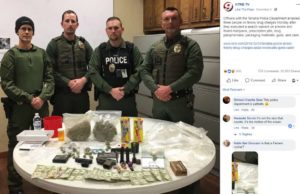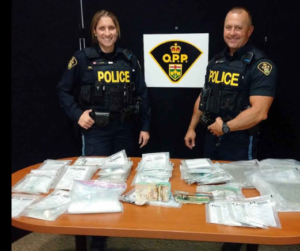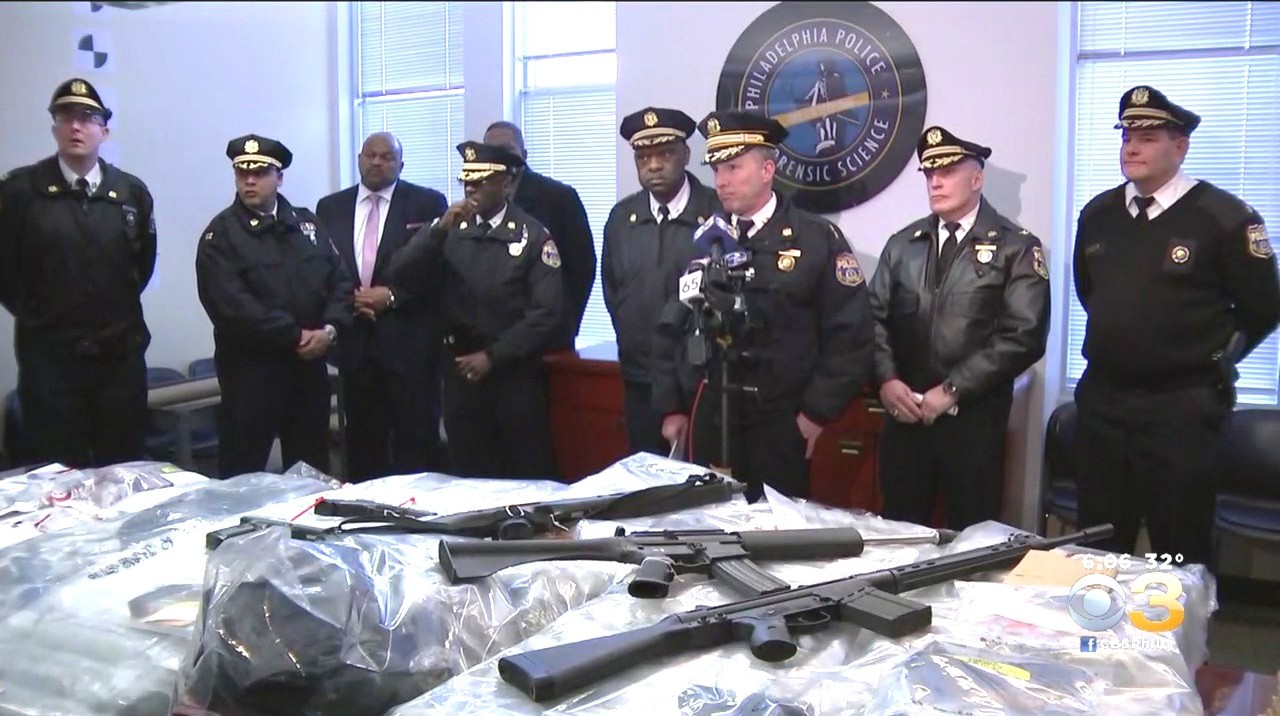It’s one of the defining images of modern policing. High-ranking officers lined up at the podium, with the drugs from their latest seizure laid out on the table before them. The cameras click and flash; impressive numbers get thrown around about the supposed “street value” of the dope that’s been seized.
Everyone present loves these moments. Senior cops get to burnish their statistics; local politicians get their pictures on regional news, proudly declaring that “a blow has been struck in the War on Drugs”—and time-pressed journalists know that large quantities of drugs always generate online clicks. These events are also perfect fodder for the social media teams that have become a fixture at every police and sheriff’s department.
This sort of drugs-on-the-table photo-op policing is part of a tradition that stretches all the way back to alcohol Prohibition in the 1920s. Detectives would make sure that reporters were tipped off about a bust in advance, ready to get the magic shot of the grinning cops smashing the whiskey barrels with pick-axes.
This is what we have been trained to think successful policing looks like.
The problem is that not only is this kind of photo-op policing based on a toxic lie—it is also a contradiction of the most basic, foundational principles of what law enforcement is actually meant to be.

Police in Texas. Image via Facebook
A Violation of Ethics and Common Sense
The world’s first modern, professionalized police force was founded in Britain by Sir Robert Peel in 1829. Peel laid out nine foundational principles designed to separate the new professional force from the arbitrary, haphazard law enforcement of the past.
The Peelian Principles—with their insistence that all policing be undertaken with the consent of those policed, and free of political bias—are to this day the essential model on which almost every democratic nation has founded and developed its own law enforcement services. They are what separates free countries from police states, and one of the great democratic contributions to world civilization.
The essential problem comes when we hit Principle 9: “the test of police efficiency is the absence of crime and disorder, and not the visible evidence of police action in dealing with them.”
There’s a dirty secret that every cop in that room knows.
Now, think back to that photo-op scene with the drugs on the table and the cameras flashing. There’s a dirty secret that every cop in that room knows.
No matter how many bags of drugs are piled on the table, the drug supply is never actually interrupted. Ever.
Every cop, if they are being honest, admits this. Their seizures, no matter how impressive they look for the cameras, make absolutely no difference to the actual supply of drugs. All they are doing is showing evidence of activity—any activity—not reducing crime.
This truth is now becoming so obvious that it is even being admitted publicly by high-level law enforcement. This week, Vince O’Brien, head of operations for Britain’s National Crime Agency (equivalent to the FBI), publicly stated:
“While there is [a] user base willing to spend millions and millions of pounds on drugs … we will have an issue with illicit drugs in this country … We can’t arrest our way out of that … We need to tackle the drivers behind it.”
Drug crime is categorically different than other sorts of criminality. If you arrest a professional burglar, then burglary rates in an area will likely go down, at least temporarily; there are relatively few people with the skills and motivation to burgle houses for a living.
Illicit drug markets simply don’t work like this. No matter how many users or dealers you arrest, the fundamental demand for the product remains constant (and perhaps even increases due to the trauma of imprisonment, family separation, etc.). Expert estimates indicate that only 1 percent of the drugs flowing into the UK are ever seized, and figures for the US are similarly tiny.
The business allowances that cartels make for police seizures are proportionately smaller than most main-street retailers make for shoplifting.
A Guaranteed Way to Increase Violence
But in fact, the dynamic is even more toxic. That photo-op moment with the drugs on the table is grotesque not only because it never decreases the drug supply, but because it actively increases violence.
It is another universal truth of any prohibition regime that if you take out one kingpin, all you do is instigate a turf war between his lieutenants and rivals over his territory. It’s a phenomenon sometimes known as the “freelancer effect.”
This was true throughout 1920s Prohibition, and it is true now—from the jungles of Latin America, to the poppy fields of Afghanistan, to the inner cities of the US and Europe. So whenever you see those drugs piled on the table with the cameras flashing, be absolutely clear with yourself: These actions have created more violence on the streets.
In our book Good Cop, Bad War we explored in detail how the dynamics of the War on Drugs function as an arms race. The police develop new techniques to arrest dealers, so gangs respond in the only way they can: by increasing violence and intimidation. There is never any potential for de-escalation, and the dynamic can only ever lead one way. This progression is unique to prohibition policing.
It is an exact negative image of what law enforcement should look like.
Even the most cursory look at the history of the War on Drugs reveals the ever-increasing damage it has caused over decades, through mass incarceration and needless deaths—inflicted disproportionately on poor people and people of color. In addition to these horrific harms, the War on Drugs is also a betrayal of police officers themselves—many of whom fight the war unwillingly and suffer trauma and psychological problems as a result.
The drug-seizure photo op is not simply a neglect of Peel’s Principles, but an active betrayal of them. It is an exact negative image of what law enforcement should look like.
In the end, we will look back on these modern drugs-on-the-table photo-ops with the same cringe at a pathetic, destructive lost cause that we apply to those black-and-white images of Prohibition agents smashing whiskey barrels.

Police in Ontario, Canada
The first casualty of any war is the truth. Drug war propaganda rages daily across news channels, front pages and social media accounts—and is seized upon by politicians. Yet Peel’s Principle 5 demands that police always demonstrate, “absolutely impartial service to law, in complete independence of policy.” By playing to the gallery and allowing law enforcement to become a political photo opportunity, police are abrogating their duty of impartiality, crossing the line to become politicized actors in support of this destructive set of policies.
This betrayal must not be allowed to continue.
We present this article as an opinion piece designed for active protest. We ask that you bookmark it, and post it in the comments section every single time you see a police department social media account flashing photos and trumpeting its latest “success.”
Let’s let them know that this game is played out. Don’t let police get away with betraying their most sacred, foundational principles for social media likes.
Main photo: drugs and guns seized by Philadelphia police in March 2019, via CBS





Show Comments